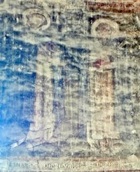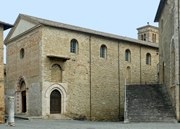
This church stands on the site of an ancient oratory that was dedicated to St George, which gave its name to the northeast quarter of Bevagna. This, in turn, was built above a Roman warehouse.
The church was closed in 2016 because of problems with the roof.
Blessed James Bianconi
In 1291 the commune gave the site to the Blessed James Bianconi as reward for his aid to refugees after the Emperor Frederick II sacked Bevagna in 1249. He rebuilt the church and established an adjacent convent.
SS George and Dominic appeared to the Blessed James as he here died in 1301, in order to reward him for the honour that he had shown to them. The church still contains two wooden sculptures (see below) that the Blessed James bought in Perugia, much to the disgust of his mother who had given him the money for clothes. One of these was a crucifix that was said to have covered the Blessed James with blood as he prayed before it.
The Blessed James died in the convent in 1301 and was interred in the Roman sarcophagus that is now on the counter-façade (to the left of the entrance).
The Dominicans built the present church (and gave it its present dedication) in 1397, probably as part of a bid for the canonisation of the Blessed James. Pope Boniface IX (1389-1404) granted indulgences to all those who prayed before his relics during the first three days of May, presumably to help pay for this restoration. (He granted similar indulgences in respect of Peter Crisci of Foligno, despite the fact that neither of these men had been canonised: this may have been part of a programme to secure allegiance to the Roman obedience during the papal schism).
Relics of Blessed James

The sarcophagus in which Blessed James was originally interred is on the counter-facade (to the right of the entrance).
The relics were re-interred in 1589 in a wooden sarcophagus painted by Ascensidonio Spacca, il Fantino, as part of a fresh attempt to secure his beatification. This sarcophagus is now in the Pinacoteca.
The relics were finally translated to the gilded bronze urn on the high altar in 1686. The urn was transferred to San Michele in 2016.
Exterior
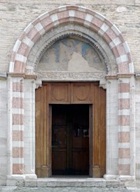
-
✴the present portal (illustrated here), with a fresco of the Madonna and Child with angels in the lunette; and
-
✴the portal that is now incorporated into the right wall, together with the aedicule above it.
Interior
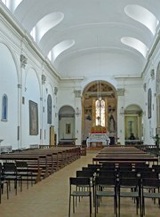
The interior is in the form of a single nave with an apse and two apsidal chapels. It was re-modeled in 1797.
Frescoes (14th century)
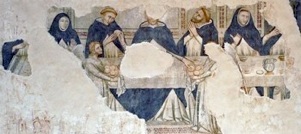
These important fresco fragments in the apse, which were rediscovered in 1920, include:
-
✴scenes from the life of St Dominic on the left wall, including:
-
•St Dominic presiding at table, where bread rolls appear miraculously (illustrated above); and
-
•a scene below it involving the burning of (presumably heretical) books; and
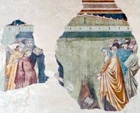
-
✴the Virgin Annunciate, on the back wall, opposite what was originally a figure of the announcing angel in a similar Gothic aedicule.
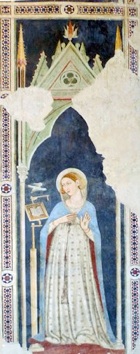
Annunciation (15th century)

Altarpieces Attributed to il Fantino (ca. 1600)
The church contains four altarpieces that are attributed to Ascensidonio Spacca, il Fantino:
-
✴The Trinity with SS Stephen, Catherine of Alexandria, Dominic, Francis, Clare and Lawrence is in the 5th bay on the right.
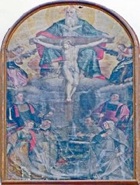
-
✴The Madonna del Rosario is in the 3rd bay on the right. A number of Dominican monks and nuns receive rosaries from the Madonna and Child, while below, a bishop and a group of nobles kneel in front of the choir of a church. The secular group includes two small children and a baby in the arms of its nurse.
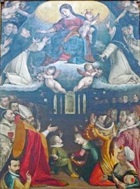
-
✴The Madonna di Constantinopoli with SS Charles Borromeo and Catherine of Alexandria is in the 1st bay on the right.
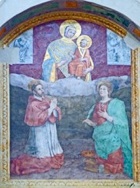
-
✴St Hyacinth’s vision of the Madonna and Child is in the 2nd bay on the left.
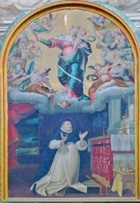
Miracle of the Crucifix (late 16th century ?)
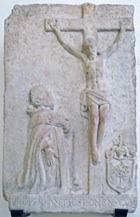
Miracle of San Domenico in Soriano (ca. 1626)
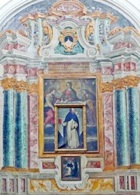
-
✴the copy of the miraculous image is attributed to Giovanni Battista Pacetti, lo Sguazzino; and
-
✴the surrounding figures of the Virgin and SS Catherine of Alexandria and Mary Magdalene are attributed to Andrea Camassei.
Miracle of the Crucifix (1642)
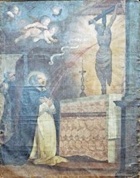
Art from the Church
Wooden Statues (ca. 1300)
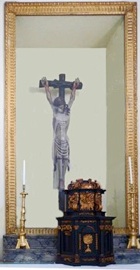
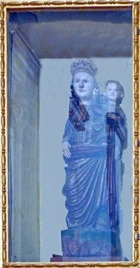
These two statues, which are thought to have been bought by the Blessed James Bianconi in Perugia were moved to the Pinacoteca in 2016:
-
✴a figure of the Madonna and Child; and
-
✴a wooden Crucifix. Once, as he prayed before it because he was experiencing doubts about his salvation, blood spurted from the image and he heard Christ saying: “This blood is the sign of your salvation”.
Both statutes were recorded in the 17th century the Cappella del Crocifisso at SS Domenico e Giacomo, which belonged to the Antici family.
Works by Andrea Camassei
A fresco (1626) of a miracle of St Dominic, which was dated by inscription and attributed to Andrea Camassei, survived in the refectory of the ex-convent until the 1960s. Three works from the church that are also attributed to him (see below) probably date to the same period:
-
✴the frescoed backdrop of the Miracles of San Domenico in Soriano, which survives in situ (above); and
-
✴two panels of SS Joseph and Antony of Padua, which are now in the Pinacoteca (see below).
The Commune paid him for three other altarpieces for the church in 1632, when the process for the canonisation of the Blessed James Bianconi was revived, but these have not survived.
SS Joseph and Antony of Padua (ca. 1626)
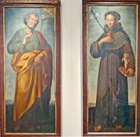
-
✴St Joseph holding the Virgin’s wedding ring and the staff that flowered in order to identify him as the chosen bridegroom.
-
✴St Antony holding his uncorrupted tongue (a relic venerated in Padua that symbolises his skill as a preacher) and an image of the baby Jesus, whom the Virgin passed to him in a vision.
Cloister

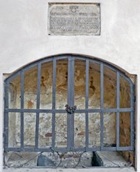
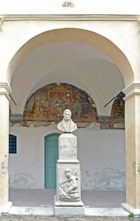
Scenes from the life of the Blessed James Bianconi (1640-1)
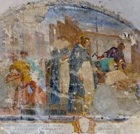
Frescoes in the ex- Chapter Room (ca. 1350)
These damaged frescoes in the Chapter Room (off the back wall of the cloister( depict:
-
✴the Crucifixion with the Virgin and SS John the Evangelist, Dominic and Thomas Aquinas;

-
✴the Pietà; and
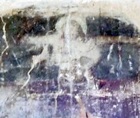
-
✴Blessed James and St Peter Martyr.
